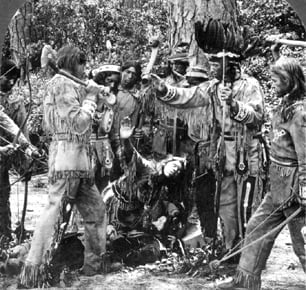
The most conspicuous stock of American Indians in early history is the Algonquian. Not only was the area occupied by the Algonquian peoples larger than that of any other stock, but the tribes and confederacies were distributed along the Atlantic coast and the rivers, estuaries, and bays opening into this ocean from Newfoundland to Cape Hatteras. The Pilgrim Fathers of New England, the Dutch traders and merchants of Manhattan island and the Hudson, the Quaker colonists of Pennsylvania, the Jesuit missionaries and Cavalier grantees of Maryland and Virginia, all encountered the native tribes and confederacies of this great stock. Further northward and in the interior Champlain, le Sieur du Lhut, Pere la Salle, and other explorers, came chiefly in contact with related peoples speaking a similar tongue. So the American Indian of early history, of literature and story, is largely the tribesman of this great northeastern stock. One of the most prominent among the confederacies of Indian tribes belonging to the Algonquian stock, in the history of the settlement of our country, was the Powhatan confederacy of tidewater Virginia and Maryland. The prominence of this confederacy in our early history is partly due to the fact that Capt. John Smith was writer as well as explorer, and left permanent records of the primitive people whose domain he invaded; but these and other records indicate that Powhatan was a chief of exceptional valor and judgment, and that the confederacy organized through his savage genius was one of the most notable among the many unions of native American tribes; also that Powhatan s successor, Opechancanough, was a native ruler of remark able skill and ability, whose characteristics and primitive realm are well worthy of embalming in history. Capt. John Smith was followed by other historians, and England and the continent, as well as the growing white settlements of America, were long interested in following the fortunes of the great tribal confederacy as the red men were gradually driven from their favorite haunts and forced into forest fastnesses by the higher race j and in later years Thomas Jefferson and other leaders of thought recorded the movements and characteristics of the people, while John Esten Cooke and his kind kept their memory bright with the lamp of literature. So the native king Powhatan, the ill-starred princess Pocahontas, and the people and the land over which they ruled, are well known, and the Powhatan confederacy has ever been prominent in history and literature. The leading tribe of the Powhatan confederacy was that from which Pamunkey River in eastern Virginia takes its name. Strongest in numbers, this tribe has also proved strongest in vitality; a few trilling remnants and a few uncertain and feeble strains of blood only remain of the other tribes, but the Pamunkey Indians, albeit with modified manners, impoverished blood, and much-dimmed prestige, are still rep resented on the original hunting ground by a lineal remnant of the original tribe. The language of Powhatan and his contemporaries is lost among their descendants; the broad realm of early days is reduced to a few paltry acres; the very existence of the tribe is hardly known throughout the state and the country; yet in some degree the old pride of blood and savage aristocracy persist and it is undoubtedly to these characteristics that the present existence of the Pamunkey tribe is to be ascribed. By reason of the prominent and typical place of the Powhatan confederacy in history and literature, it seems especially desirable to ascertain and record the characteristics physical, psychical, and social of the surviving remnant of the race. It was with this view that John Garland Pollard, Esq., of Richmond, a former attache of the Smithsonian Institution, was encouraged to make the investigation recorded in the following pages; and it is for this reason that the record is offered to the public. W. J. McGee The information here given to the public concerning the present condition of the Pamunkey Indians was obtained by the writer during recent visits to their reservation. He wishes to acknowledge his indebtedness to the tribe for the kindness with which they have treated him, and to make special mention of Mr. Terrill Bradby, Mr. William Bradby and Chief C. S. Bradby, who have made a willing response to all of his inquiries.
Pamunkey Indians of Virginia
- Early History of the Pamunkey Indians
- Present Home of Pamunkey Indians
- Characteristics of Pamunkey Indians
- Language of of the Pamunkey
- How the Pamunkey Indians Live
- Pamunkey Government and Tribal Laws
- Art of the Pamunkey Indians
As to the past condition of the tribe, the authorities consulted were the following:
- The True Travels, Adventures, and Observations of Captain John Smith, Richmond, 1819. Vols. 1 and 2.
- Notes on the State of Virginia, by Thomas Jefferson: Philadelphia, 1801.
- Historical Recollections of Virginia, by Henry Howe, Charleston, 1849.
- Virginian, by John Esten Cooke, Boston, 1883.



Are the pamunkey Davenport’s native american?
Hello, I currently use Ancestry.com and they have indicated that I may be related to Nonoma Winanuske Matatiske. If this is correct she would be my 13th Great Grandmother. Ancestry could be wrong so I’m trying to hold back my excitement. Myself and my Uncle will study the links better before we celebrate.
My line according to Ancestry goes through her daughter Tatacoopa Susan Taylor. This is very interesting to me since my mothers maiden name was Taylor. Although the Taylor’s were all over the Pamunkey Territory in Virginia.
Since the child of Powhatan and Nonoma was a MALE, the claim of the child being Susan Taylor is fake. For more information:
https://www.wikitree.com/wiki/Taylor-17311
Still looking by chance? I know the article is old. But I may be able to help.
Thanks have a great day
My email is all lower case
I am looking for my ancestors from The Pamunkey Indian Reservation in King William, VA.